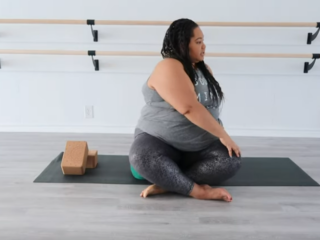Yoga is a form of mindfulness. It is the practice of controlling and directing the mind, body, breath, and senses through various physical postures or controlled breathing exercises.
Mindfulness is a form of meditation that focuses on the present moment, while yoga is an exercise routine. Yoga has been linked to many health benefits such as increased flexibility and reduced stress levels.
It’s possible that some of the links in this article are affiliate links. For additional information, please read our disclaimer.
Have you ever wanted to practice meditation but found it difficult to sit still? Meditation is widely practiced because it is a kind of awareness. It’s a technique for calming the mind, moving within, and training the mind to concentrate on a single place. What about yoga, though? Is it possible to include mindfulness into your yoga practice?
Is yoga, therefore, a kind of mindfulness? Yes. Yoga is unquestionably a kind of mindfulness. Your yoga practice may help you be more present in each breath and posture. Yoga is a wonderful method to bring your mind, body, and soul together.
Yoga is an excellent method to train yourself to be completely aware and present in each moment. Have you ever attempted to stay balanced in Tree Pose while thinking about your to-do list? When your mind is elsewhere, it’s difficult to breathe through your practice! Yoga postures help you pay attention to your body and teach you how to breathe through pain. When these techniques are taken off the mat and into the real world, yoga becomes a mindfulness practice.
What Is the Difference Between Meditation and Mindfulness?
It’s a good idea to clarify the distinction between meditation and mindfulness before we get into how yoga may be a kind of mindfulness. The two are sometimes used interchangeably, despite the fact that they are quite different and distinct.
What is the definition of meditation?
Meditation is a technique for transforming your mind by going inside and focusing on a single spot. Simply focusing on your breath, developing a sense of love, or practicing appreciation may help you relax. People meditate for a variety of reasons, including improved clarity and focus, promoting a feeling of peace throughout the body and mind, and spiritual reasons.
- What does it mean to meditate? Mediation is usually done with a motionless body, either sitting or lying down on a cushion or chair. Your eyes may be closed or slightly open, and your mind will begin to relax as your body settles into the present moment. While meditating, keep your spine straight and your body comfy.
- What methods do individuals use to meditate? Guided meditations or group meditation courses are quite popular and can be obtained simply online or in studios. You may also practice at home by concentrating on a single spot and slowing your thoughts down. Meditations that concentrate on the breath, mantras, your inner guidance, love, or even the practice of mindfulness are examples of certain meditations.
What is the definition of mindfulness?
Mindfulness is the deliberate ingestion of the whole experience of the current moment. Mindfulness is when you are totally aware of what is going on in the current moment and fully present in the “now.”
- What is the best way for me to practice mindfulness? Being completely present in each moment is what mindfulness entails. Your mind may sometimes attach itself to the future or the past, leading you to be less present in the current moment. Mindfulness entails fully perceiving the present moment without being attached to it or casting judgment on it.
- What places do I go to practice mindfulness? Mindfulness may be practiced anywhere and at any moment. For example, the next time you’re in a difficult situation, observe whether you respond quickly and instead stop. Be aware of your response and pay attention to how you feel in your body. Take a deep breath to bring yourself back to your body and the present moment.
Why Should I Try to Be More Mindful?
Mindfulness is an excellent everyday practice to develop. It offers many advantages for both you and others with whom you deal on a regular basis. It may enhance your general quality of life and help you feel more connected to yourself and the rest of the world. Finding little opportunities to practice mindfulness throughout the day can benefit many aspects of your life, including your relationships and productivity.
Though you may practice mindfulness outside of your yoga mat, you can also do so on it. Practicing yoga and attending yoga classes are excellent ways to cultivate awareness. It may be simpler to practice Mindfulness off your mat if you are able to practice it on your mat. You may take a deep breath and tell yourself to be aware of your response instead of responding immediately.
Mindfulness’s Advantages
You may see and feel changes in and around you as you begin to practice mindfulness. Mindfulness may help you become more aware of your internal world and emotions, and it offers a number of advantages. Mindfulness has the ability to:
- Stress, anxiety, sadness, and rage may all be reduced.
- Blood pressure should be reduced.
- Improve your general health, as well as your attention span, patience, self-esteem, memory, emotional responses, listening abilities, and sleeping habits.
- Boost your attention and concentration, as well as your awareness, confidence, and self-control.
- Gratitude, compassion, creativity, and connection are all virtues to cultivate.
Mindfulness as a Yoga Practice
You may not know it, but whether you are led by a teacher in a studio or via a video during your yoga practice, your instructor will nearly always lead you into a state of awareness. They may encourage you to be more aware of your breath at the start of practice, and they may remind you to check in with your body and any feelings you may be experiencing during the session.
Yoga pulls you into the present now, and when you practice with an experienced instructor, you may reach a higher level of awareness. All of your teacher’s signals and instructions, as well as reminders regarding your breath and encouragement to remain present through uncomfortable times, are oriented toward mindfulness. So the next time your instructor says, “Check in with your body and your breath,” take advantage of it to practice Mindfulness.
During Yoga, Here Are Some Tips for Practicing Mindfulness
Do you want to be more attentive when doing yoga? Though your yoga instructor may automatically lead you to a state of awareness, there are a few things you can keep in mind throughout your practice.
Here are some suggestions to assist you in practicing mindfulness:
- Remove all electronic devices from your practicing area: Social media, smartphones, and tablets are all wonderful, but they can also be very distracting. Keep your devices out of the studio to keep your practice area free of distractions.
- Make a modest goal for yourself: Setting an objective before you begin your practice may assist you in being more attentive during the session. It may be as easy as paying attention to your body or concentrating on your exhales throughout class.
- Allow yourself to let go of any expectations: During your practice, try not to set any goals for yourself. Enjoy the ebbs and flows of your practice by living and breathing in each moment.
- Take notice of how your body feels in each new pose: As you go into your yoga poses, pay attention to how your body feels in each new form. See if you can be aware without passing judgment or making up a narrative about how you’re feeling.
- Let comparisons go: each body and each practice are unique. Allow yourself to concentrate entirely on yourself rather than comparing yourself and your practice to others.
- Observe your feelings: During your yoga practice, you may experience emotions. Simply be aware of what arises and try not to attach yourself to them.
Mindfulness Practices for Everyday Life
Even if you aren’t on your yoga mat or sitting on a meditation cushion, you can practice mindfulness. Anything may be done thoughtfully as long as your entire attention and purpose are focused on the present moment. Try to remain as much as possible in the present moment, and don’t get upset or give up if your mind wanders – remember, it’s a practice.
Here are some methods to incorporate mindfulness into your daily routine:
- Make a self-check-in: Take 5 deep breaths a couple times a day while doing this. Keep your attention on how you’re feeling and the emotions and sensations that emerge.
- Make a list of things you’re grateful for: In your diary or in your thoughts, write down 5 things for which you are thankful. This brings you into the present moment and away from future or previous thoughts.
- Take notice of all the various tastes and textures, as well as the smell and feel of your food, and avoid multitasking while eating.
- Breathe: Throughout the day, pay attention to your breathing. Take note of if you’re breathing too quickly or not deeply enough.
- Spend time outside: Go on a stroll in the woods or on the beach and notice all the little nuances that nature has to offer.
You may not be aware that you are practicing Mindfulness throughout your yoga session, but you are! When you are more aware of your breath, responses, body, and emotions when on your mat, it may carry over into your life off the mat. A more conscious existence may bring greater happiness, appreciation, and presence into one’s life. Be mindful of not just your yoga practice but also your Mindfulness practice the next time you’re on your mat!
Mariel is a yoga instructor and writer living in New York City. She has been teaching for ten years and has been a lifelong student of the old art.
Mindfulness is a state of active, open-minded attentiveness. Yoga is an ancient practice that promotes mindfulness and mental focus. It’s important to note that yoga isn’t the only form of mindfulness, but it does have a lot in common with other practices such as meditation or deep breathing exercises. Reference: mindfulness yoga poses.
Frequently Asked Questions
Is yoga considered mindfulness?
Yoga is a type of exercise that focuses on the body, mind, and spirit. It is considered to be a form of mindfulness as it helps you focus on your breathing and movements.
What is the correlation between mindfulness and yoga?
Mindfulness is the practice of being aware of your thoughts and actions, while yoga is an exercise that focuses on physical fitness.
What are some mindfulness exercises?
The following are some mindfulness exercises that you can do to help reduce stress, anxiety, and depression.
Related Tags
- what is mindful yoga
- mindful yoga for beginners
- mindfulness yoga benefits
- mindfulness meditation yoga
- yoga and mindfulness course














